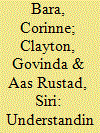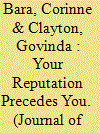|
|
|
Sort Order |
|
|
|
Items / Page
|
|
|
|
|
|
|
| Srl | Item |
| 1 |
ID:
134450


|
|
|
|
|
| Summary/Abstract |
Existing research on the causes of violent ethnic conflict is characterized by an enduring debate on whether these conflicts are the result of deeply felt grievances or the product of an opportunity structure in which rebellion is an attractive and/or viable option. This article argues that the question of whether incentive- or opportunity-based explanations of conflict have more explanatory power is fundamentally misguided, as conflict is more likely the result of a complex interaction of both. The fact is, however, that there is little generalized knowledge about these interactions. This study aims to fill this gap and applies crisp-set Qualitative Comparative Analysis (QCA) in order to identify constellations of risk factors that are conducive to ethnic conflict. The results demonstrate the explanatory leverage gained by taking causal complexity in the form of risk patterns into account. It takes no more than four different configurations of a total of eight conditions to reliably explain almost two-thirds of all ethnic conflict onsets between 1990 and 2009. Moreover, these four configurations are quasi-sufficient for onset, leading to conflict in 88% of all cases covered. The QCA model generated in this article also fares well in predicting conflicts in-sample and out-of-sample, with the in-sample predictions being more precise than those generated by a simple binary logistic regression.
|
|
|
|
|
|
|
|
|
|
|
|
|
|
|
|
| 2 |
ID:
171966


|
|
|
|
|
| Summary/Abstract |
In the past two decades, regional organizations and coalitions of states have deployed more peace operations than the UN. Yet most quantitative studies of peacekeeping effectiveness focus on UN peacekeeping exclusively, a decision owed to data availability more than to theories about the differential impact of UN and non-UN missions. As a result, we know little about the effectiveness of non-UN peacekeeping in mitigating violence. In this paper, we introduce and analyse monthly data on the approximate number of troops, police, and observers in both UN and non-UN peacekeeping operations between 1993 and 2016. Using these data, we show that when accounting for mission size and composition, UN and regional peacekeeping operations are equally effective in mitigating violence against civilians by governments, but only UN troops and police curb civilian targeting by non-state actors. We offer some theoretical reflections on these findings, but the main contribution of the article is the novel dataset on non-UN peacekeeping strength and personnel composition to overcome the near-exclusive focus on UN missions in the scholarship on peacekeeping effectiveness.
|
|
|
|
|
|
|
|
|
|
|
|
|
|
|
|
| 3 |
ID:
161606


|
|
|
|
|
| Summary/Abstract |
Civil wars have a tendency to spread across borders. In several instances of conflict diffusion, however, conflicts spread well after their cessation at home. Whereas existing diffusion research has not attached much importance to this observation, I argue that these conflicts are instances of a broader pattern of postconflict diffusion. Wars are particularly prone to spread after termination because the end of fighting generates a surplus of weapons, combatants, and rebel leaders whose fortunes are tied to the continuation of violence. Some of these resources circulate throughout the region via the small arms trade and through transnational rebel networks, making this a time at which it should be easier for nonstate groups in the neighborhood to build a capable rebel army. The results from two complementary statistical tests on global conflict data provide strong support for such a postconflict diffusion effect.
|
|
|
|
|
|
|
|
|
|
|
|
|
|
|
|
| 4 |
ID:
188193


|
|
|
|
|
| Summary/Abstract |
Private military and security companies (PMSCs) and mercenaries are a common feature in civil wars, yet little systematic analysis of PMSC involvement and conflict dynamics exists. This article explores whether civil conflicts that feature PMSC forces in combat are more likely to recur. We contend that the presence of PMSCs in fighting exacerbates the postwar credible commitment problem, as belligerents will be concerned about the possibility to redeploy such forces in the future. Belligerents pay more attention to more recent and more visible information, meaning that the effects should be greatest if PMSCs feature extensively in combat and at the end of the conflict. A duration analysis of data from the Private Security Events Database and Uppsala Conflict Data Program, 1990–2014, offers robust support for these claims. Our results suggest that conflict management should consider aspects beyond the local context as risk factors for civil war recurrence.
|
|
|
|
|
|
|
|
|
|
|
|
|
|
|
|
| 5 |
ID:
178369


|
|
|
|
|
| Summary/Abstract |
Ceasefires are arrangements in which conflict parties commit to temporary or permanent cessation of violence.
|
|
|
|
|
|
|
|
|
|
|
|
|
|
|
|
| 6 |
ID:
193112


|
|
|
|
|
| Summary/Abstract |
How does the state’s behavior in negotiations with one non-state group influence the behavior of other non-state actors? We argue that the dynamics of different conflicts within the same country are interdependent, and that a state develops a reputation through its interactions with each conflict party. This reputation provides a valuable source of information that other groups use to judge the state’s cooperative intentions. When a state develops a reputation for cooperation, this increases the likelihood of (indirect) reciprocation from other groups. More specifically, we argue that when states enter into (and honor) a ceasefire with one rebel group, they demonstrate a credible reputation for cooperation. A credible reputation for cooperation, we posit, increases the likelihood that other conflict parties enter into ceasefires with the state, or that they de-escalate their military activities. We test our claims using the new civil conflict ceasefire dataset and find support for our argument.
|
|
|
|
|
|
|
|
|
|
|
|
|
|
|
|
|
|
|
|
|